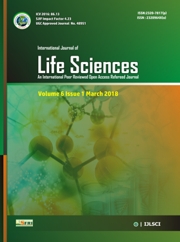RESEARCH ARTICLES
Volume 8 |Issue 3| May-June 2020 First published: 30 June 2020
GC-MS aspect of moss Funaria hygrometrica Hedw.
Wankhede TB
Department of Botany, Shri Shivaji Science College, Amravati, MS, India
Email: tusharwan@gmail.com
Abstract
Keywords:Moss, Phytochemicals, GC-MS analysis, Potency, drug design
Editor: Dr.Arvind Chavhan
Cite this article as:
Wankhede TB. GC-MS aspect of moss Funaria hygrometrica Hedw, Int. Res. Journal of Science & Engineering, 2020, Volume 8(3): 121-124.
Copyright
Open Access This article is licensed under a Creative Commons Attribution 4.0 International License, which permits use, sharing, adaptation, distribution and reproduction in any medium or format, as long as you give appropriate credit to the original author(s) and the source, provide a link to the Creative Commons license, and indicate if changes were made. The images or other third party material in this article are included in the article’s Creative Commons license, unless indicated otherwise in a credit line to the material. If material is not included in the article’s Creative Commons license and your intended use is not permitted by statutory regulation or exceeds the permitted use, you will need to obtain permission directly from the copyright holder. To view a copy of this license, visit http://creativecommons.org/ licenses/by/4.0/
References
1.Saxena DK and Harinder. Uses of bryophytes. Resonance, 2004, 9: 56-65.
2. Singh M, Rawat, AKS and Govindarajan R. Antimicrobial activity of some Indian Mosses. Fitoterapia., 2007, 78: 156-158.
3. Sadashivam S and Manickam A. Biochemical Methods, New Age International Publishers, New Delhi: 1996, 193-199.
4. Krishnan R, Manaj GS and Murugan K. In vitro microcidal potentiality of Targionia hypophylla L. and Bryum species-Bryophyte. International Journal of Pharmacy and Pharmaceutical Sciences, 2012, 4 (2): 410-413.
5. Singh Meenakshi, Raghvan G, Nath V, Singh AK, Rawat and Mehratra S. Antimicrobial, wound healing and antioxidant activity of plagiochasma appendiculatum Lehm. et. Lind. Journal of microbiology, 2006, 7 (2): 11-16.
6. Chopra RN and Kumar PK. Biology of Bryophytes, New Age International (P) Limited Publishers, 1988: 41-68.
7. Dr. Duke’s phytochemical and ethnobotanical database https://phytochem.nal.usda.gov/
8. Ozdemir G, Karabey NU, Dalay MC and Pazarbasi B. Antibacterial activity of volatile compounds and various extracts of Spirulina platensis. Phytother. Res., 2004, 18 (9): 754-757.
9. Ibrahim NA, Hawary EI, Mohammad MD, Faraid MA, Nayera AM. Chemical composition antimicrobial activity of essential oil of the flower Paulownia tomentosa growing in Egypt. Journal of applied Science Research, 2013, 9 (4) 3228-3232.
10. Agnihotri S, Wakode S and Agnihotri A. An overview of anti-inflammatory properties and chemo-profile of plants used in traditional medicine. Indian Journal of Natural products and resources, 2010, 1 (2): 150-167.
11. Naz I, Khan MR, Ali S, Khan SM. Antibacterial activity of secondary metabolites from Funaria parviflora (Lam.) Funariaceae. Int. J. Pharma. Sci. Rev. Res., 2013, 23 (1): 29-36.
12. Bodade RG, Borkar PS, Arfeen S, and Khobragade CN. In-vitro screening of bryophytes for antimicrobial activity. Journal of Medicinal Plants, 2008, 7 (4): 23-28.
13. Claude Leray. Introduction to Lipidomics; from Bacteria to Man. CRC Press, Taylor and Franscis group, Florida, 2013, 120-134.

